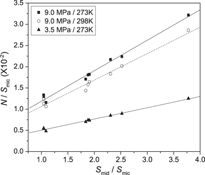Crossref Citations
This article has been cited by the following publications. This list is generated based on data provided by
Crossref.
Ge, Qilong
Tian, Qi
Moeen, Muhammad
and
Wang, Sufang
2020.
Facile Synthesis of Cauliflower Leaves Biochar at Low Temperature in the Air Atmosphere for Cu(II) and Pb(II) Removal from Water.
Materials,
Vol. 13,
Issue. 14,
p.
3163.
Lei, Bingman
Liu, Biyan
Zhang, Huijun
Yan, Libei
Xie, Hongmei
and
Zhou, Guilin
2020.
CuO-modified activated carbon for the improvement of toluene removal in air.
Journal of Environmental Sciences,
Vol. 88,
Issue. ,
p.
122.
Lei, Bingman
Xie, Hongmei
Chen, Shengming
Liu, Biyan
and
Zhou, Guilin
2020.
Control of pore structure and surface chemistry of activated carbon derived from waste Zanthoxylum bungeanum branches for toluene removal in air.
Environmental Science and Pollution Research,
Vol. 27,
Issue. 21,
p.
27072.
Li, Chun-Yang
Lv, Shi-Wen
Yang, Lu
Wang, Jin
Liu, Jing-Min
and
Wang, Shuo
2022.
Facile Preparation of Uniform-Sized Covalent Organic Framework Nanoflowers as Versatile Sample-Pretreatment Platforms for Sensitive and Specific Determination of Hazardous Substances.
SSRN Electronic Journal ,
Li, Chun-Yang
Lv, Shi-Wen
Yang, Lu
Wang, Jin
Liu, Jing-Min
and
Wang, Shuo
2022.
Facile preparation of uniform-sized covalent organic framework nanoflowers as versatile sample-pretreatment platforms for sensitive and specific determination of hazardous substances.
Journal of Hazardous Materials,
Vol. 438,
Issue. ,
p.
129566.
Xie, Hongmei
Liu, Na
Wang, Haoyu
Chen, Shuang
Zeng, Jia
and
Zhou, Guilin
2023.
Activated carbon with high mesopore ratio derived from waste Zanthoxylum bungeanum branches by KNO3-assisted H3PO4 staged activation for toluene adsorption.
Environmental Science and Pollution Research,
Vol. 30,
Issue. 47,
p.
104194.
Zhou, Guilin
Liu, Wenjing
Zhao, Yue
Wang, Xiaoping
Chen, Shuang
Jia, Aiping
and
Xie, Hongmei
2024.
Reversible hydrogenation and dehydrogenation of benzene for hydrogen storage on highly dispersed Pd/γ-Al2O3 catalyst.
Journal of Industrial and Engineering Chemistry,
Vol. 134,
Issue. ,
p.
561.
Zhou, Dongsheng
Sun, Hanfeng
Guo, Shihai
Zhao, Dongliang
Li, Jun
and
Zhang, Yanghuan
2024.
Hydrogen storage properties of Mg-based alloys modified with metal-organic frameworks and carbon-based porous materials: A review and summary.
International Journal of Hydrogen Energy,
Vol. 57,
Issue. ,
p.
1373.
